#Melvyn Grant
Explore tagged Tumblr posts
Text
Iron Maiden: The Final Frontier (2010)








Cover Art by Melvyn Grant
Universal Music
#my vinyl playlist#bruce dickinson#dave murray#steve harris#adrian smith#janick gers#nicko mcbrain#melvyn grant#universal music#hard rock#heavy metal#nwobhm#new wave of british heavy metal#compact disc#album cover#album art
29 notes
·
View notes
Photo

On June 11, 1992
#Iron Maiden#fear of the dark#fear of the dark era#Corrosion Of Conformity#Blind era#Testament#flyer#On June 11 1992#90s#90's#heavy metal#thrash metal#crossover#1992#Melvyn Grant#Melvyn Grant (b. 1944)#art#eddie the head
193 notes
·
View notes
Text

'Space Vikings' poster (1977). Artwork by Melvyn Grant.
#vintage poster#1970s#melvyn grant#space vikings#science fiction#vintage illustration#sci fi#futuristic#spaceship#spacecraft#retro futuristic
23 notes
·
View notes
Text

Melvyn Grant
13 notes
·
View notes
Text

Melvyn Grant
5 notes
·
View notes
Text
#1173: I Like Iron Maiden...A Lot
RECORD STORE TALES #1173: I Like Iron Maiden…A Lot In 1984, I “rebooted” my musical taste and started from ground zero. Out went Styx for almost two decades. Out went Joey Scarbury, and Kenny Rogers. In came KISS, W.A.S.P., and of course, Iron Maiden. I don’t think there was ever a time that Iron Maiden were my #1 favourite band, because Kiss almost always held that spot. It is safe to say…
#50 Years of Iron Maiden#adrian smith#blaze bayley#Bruce Dickinon#bruce dickinson#clive burr#dave murray#dennis stratton#dennis wilcock#derek riggs#doug sampson#eddie#fear of the dark#Harrison#Iron Maiden#janick gers#martin birch#melvyn grant#nicko mcbrain#no prayer for the dying#paul day#paul di&039;anno#Simon Dawson#steve harris#tony parsons
0 notes
Text



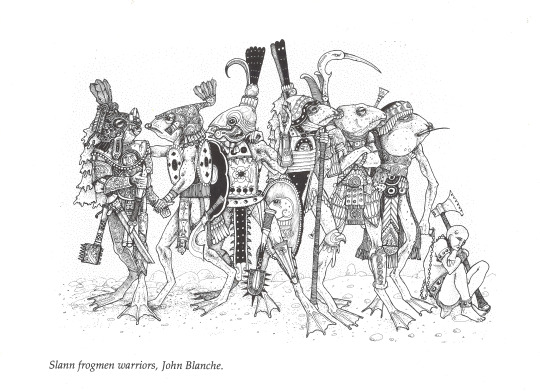
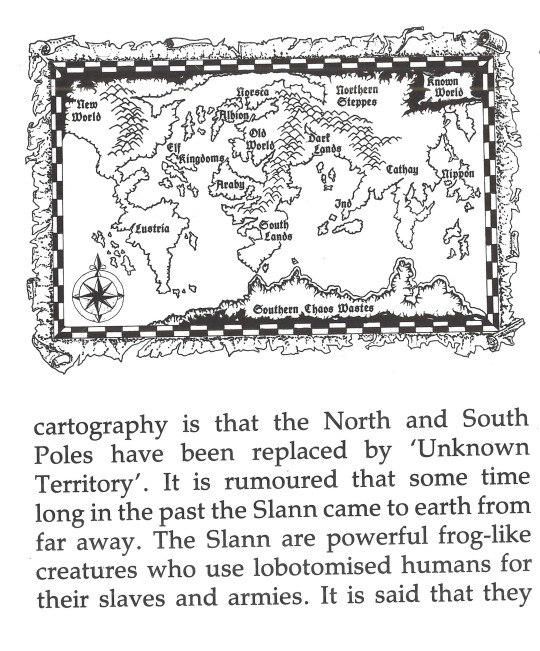

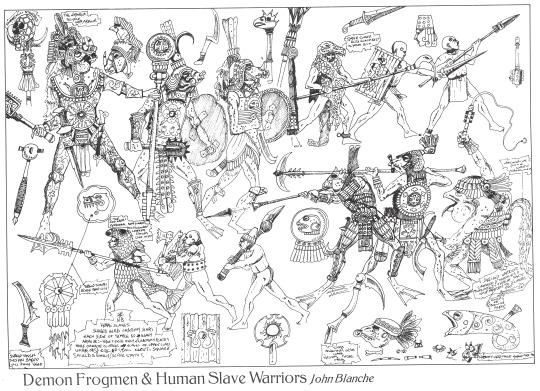

Heroes for Wargames
Stewart Parkinson Paper Tiger, 1986
A book about miniatures and tabletop miniatures wargames. Published by Paper Tiger in partnership with Games Workshop, focusing almost exclusively on Citadel miniatures and Games Workshop games.
Notable today for featuring photos of Space Marines (called "Deep Space Mercenaries" in HfW) a year before the debut of Warhammer 40,000: Rogue Trader, and sketches of the Slann over a decade before the first Lizardmen army was released for Warhammer Fantasy Battle.
#Wargames#Miniatures#Games Workshop#Citadel Miniatures#Heroes for Wargames#John Blanche#Dave Andrews#Melvyn Grant#Bob Naismith#Deep Space Mercenaries#Slann#Paper Tiger
1 note
·
View note
Text




AVIAN WARFARE ON WINGS OF DEMON STEEL -- THE SCI-FI CREDIBILITY OF PROTO-METAL GODS.
PIC(S) INFO: Mega spotlight on textless cover art to "The Steel Tsar," a 1981 sci-fi/alternate history/steampunk novel written by Michael Moorcock. Artwork by Melvyn Grant.
EXTRA INFO: The same cover art was used for the 1984 reissue of Judas Priest's 1974 debut album "Rocka Rolla" and the 1989 [futuristic sports] video game "Ballistix."
Sources: www.reddit.com/r/CoolSciFiCovers/comments/1djjtvz, Moby Games, various, etc...
#JUDAS PRIEST#JUDAS PRIEST 1974#Heavy rock#Melvyn Grant Artist#Robots#Rocka Rolla 1974#JUDAS PRIEST Rocka Rolla 1974#Rocka Rolla#Rock and roll#Michael Moorcock#Gaming#Rocka Rolla 50th Anniversary#1970s#70s Style#The Steel Tsar#Ballistix#1974#Video games#70s Sci-fi Art#Science fiction#Melvyn Grant#70s rock#Rocka Rolla 1974 50th Anniversary#Progressive rock#Sci-fi Art#Super Seventies#Hard rock#Sci-fi Fri#70s Sci-fi#Sleeve Art
0 notes
Text
A mistaken excerpt from an interview with Melvyn Douglas in 1980 Toronto, taken from Conversations with Classic Film Stars: interviews from Hollywood's golden era (2016) by James Bawden and Ron Miller. The "It" at the beginning is the film Ninotchka (1939).

Accoring to imdb, Too Many Husbands was released on March 21, 1940 and My Favorite Wife was released two months later on May 17 1940. Despite being released later, My Favourite Wife was more popular with audiences, so Mr Douglas isn't wrong there.
Just for fun, also according to IMDB two endings were filmed for Too Many Husbands, one in which Jean Arthur ends up with Melvyn Douglas and the other in whcih she ends up with Fred MacMurray. Then Columbia screened the picture with both endings to college students at UCLA and USC. More than 10,000 questionnaires were given out and the responses decided the ending of the film!
Personally, I love both these movies and it's always hard to believe they aren't purposeful gender-reversals of each other. And they even came out the same year!


#melvyn douglas#1940#hollywood#old hollywood#classic hollywood#too many husbands#fred macmurray#jean arthur#irene dunne#cary grant#my favorite wife#randolph scott#gail patrick#columbia pictures#RKO#he stayed for breakfast#1941#1940s#loretta young#james bawden#ron miller#ninotchka#1939
9 notes
·
View notes
Text
Iron Maiden: Virtual XI (1998)








Cover Art by Melvyn Grant
CMC International Records
#my vinyl playlist#iron maiden#blaze bayley#steve harris#dave murray#nicko mcbrain#janick gers#melvyn grant#CMC international records#hard rock#heavy metal#90’s rock#new wave of british heavy metal#nwobhm#compact disc#album cover#album art
4 notes
·
View notes
Photo
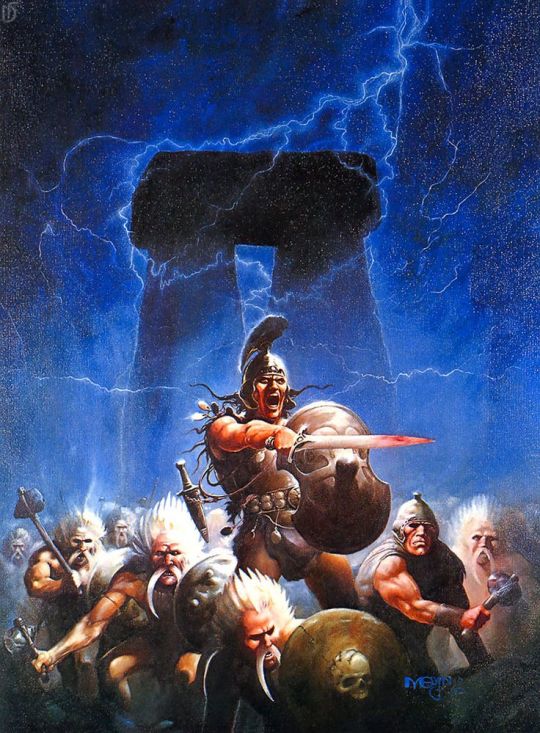


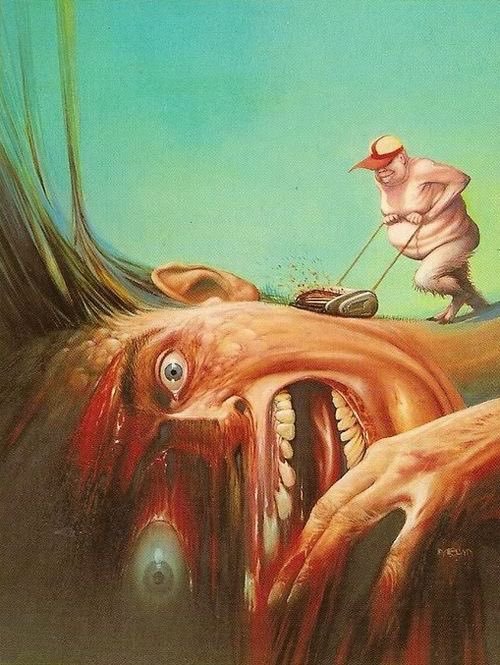
𝔐𝔢𝔩𝔳𝔶𝔫 𝔊𝔯𝔞𝔫𝔱 (𝔟. յգկկ)
#Melvyn Grant (b. 1944)#art#artwork#cover#slasher#brutal art#artworks#fear of the dark#iron maiden#cover art#judas priest#tyrant#gladiador#painting#Melvyn Grant
191 notes
·
View notes
Note
❤️ extravagantliar
Send ❤️ + a URL and I’ll write something nice about them/their blog!
@extravagantliar you’ve been named and shamed.
Their writing is some of the most phenomenal I’ve ever known and I enjoy reading everything they have to offer and I will always promote their work. I love the way they write multiple characters and how the writing is still tailored to each character (Hojo, Hughes, etc).
They know how to hit you where it hurts and their vocabulary is amazing and constantly tripping me up - which is wonderful as it causes me to look things up so I improve with my own.
One of their defining traits in my eyes is how they always manage to become a center piece in a fandom by way of their storytelling abilities and general knowledge on how things work, leading to some insane meta building posts.
Truly, nobody else could write Varric better. That is to say, I’m sure there are others out there who write him wonderfully - but they will never hold the same magnetism Elisa has to be able to draw so many people in such a way that inspires me. And makes me awfully envious, too.
May I consider myself their foil, as a little treat?
#I don’t have enough words to describe how much I love Elisa.#they will always hold a piece of my heart (granted it’s probably kept in a tiny prison cell for crimes against humanity but I digress)#most importantly; they are the only friend I know that understands the loss I have been through and where it has taken me in life.#Melvyn sends his regards.#uncrushable pigeon.
4 notes
·
View notes
Text
Three Cary Grant movies in a row!
Script below the break
Hello and welcome back to The Rewatch Rewind! My name is Jane, and this is the podcast where I count down my top 40 most rewatched movies. Today I will be discussing number 28 on my list: RKO’s 1948 comedy Mr. Blandings Builds His Dream House, directed by H.C. Potter, written by Norman Panama and Melvin Frank, based on the novel by Eric Hodgins, and starring Cary Grant, Myrna Loy, and Melvyn Douglas.
Yes, I’m talking about yet another Cary Grant movie – I warned you there would be a lot of them. In this one, he plays Jim Blandings, an advertising executive who lives in a Manhattan apartment with his wife Muriel (Myrna Loy) and their two children. Tired of feeling crowded, and taken in by an advertisement, they decide to purchase an old house on a large property in Connecticut. They initially resist the idea that the house must be torn down, but ultimately get excited about being able to build one to their own specifications. However, this is not nearly as simple, or as affordable, as they anticipate.
The first time I watched this movie, it was late at night and I was very tired, so I remember almost falling asleep without really getting into it. But I enjoyed it a lot more the second time, and it’s grown on me over the years. I watched it for the first time in 2003, then twice in 2004, and then once each in 2006, 2008 through 2013, 2015, 2016, 2018 through 2021, and then twice in 2022. And while I could barely keep my eyes open the first time I watched it, now I find it difficult to tear them from the screen when the movie is on.
As I’ve said several times in previous episodes, Cary Grant was a brilliant comedic actor, and once again, he is very funny in this movie. Just watching his morning routine in the apartment at the beginning is hilarious. Jim Blandings is very sure of himself, even and especially when he shouldn’t be, and Cary plays that very convincingly and humorously. Myrna Loy is probably best known for playing Nora Charles in the comedy-mystery Thin Man movies, so it should come as no surprise that she is also very funny here. Muriel occasionally tries to rein in some of Jim’s recklessness, but also gets caught up in the dream of the house, and Loy portrays that flawlessly. Apparently critics thought these stars were too old for these roles (they were both in their mid-40s at the time), and that it would have made more sense to show a naïve young couple not knowing how to build a house, but personally I think it works better to show a middle aged couple who have every reason to believe they know what they’re doing find out that they have no clue. The movie also makes it clear that it’s only because Jim is older and more established in his career that he’s able to do this. At one point when he’s venting about how everything’s costing way more than they were anticipating, Jim points out that if he can barely afford it, there’s no way a young couple ever could. And looking at this movie from a modern lens is kind of surreal because like, imagine a single-income family of four being able to afford a house! To put things in perspective, Jim Blandings was making $15,000 a year in 1948, which is the equivalent of approximately $190,000 in 2023, and the final cost of his dream house was $38,000, or approximately $480,000 now. It certainly costs a lot more than he initially thinks it will, but it’s still doable for him – although he does nearly lose his job at one point – whereas it would not have been for a young couple just starting out. And again, Cary Grant and Myrna Loy are so delightful to watch that I cannot comprehend wanting to replace them.
The acting and the writing encourage the audience to laugh at both Jim and Muriel while still finding them sympathetic. There’s a rather beautiful poetic justice in the story of an advertising executive, who spends all day figuring out how to convince people to buy things they don’t need and can’t afford, getting convinced by an ad to build a house he doesn’t need and can’t afford. And yet, we still want him to succeed, and share his frustration when things go wrong. Muriel’s extremely specific demands for the house can be ridiculous, but we still want her to get the dream house she desires. Perhaps her greatest moment in the film is when she spends several minutes describing in detail the exact shade she wants each room painted: one should exactly match the color of fresh butter, one needs to be white – not a cold, antiseptic hospital white, but not to suggest any other color but white; another should be practically an apple red, somewhere between a healthy Winesap and an unripened Jonathan, etc. When she finally gets distracted and walks away, one of the painters says to the other, “You got all that?” and the other replies, “Red, green, blue, yellow, white.” It’s very funny, but also maybe a little bit sexist, in a “These silly women and their ridiculous obsession with detail” way, but at least the movie makes fun of Jim too. He’s constantly taking charge of things he doesn’t understand and making them worse – from illegally authorizing the old house to be torn down to inadvertently instructing builders to rip out their work. So rather than making fun of Jim and Muriel specifically, the movie is really making fun of the gender roles they feel obligated to fulfill, and the way society has made basic needs like shelter immensely complicated to obtain. And while some of that is rather painful to face, this movie manages to make the overall experience mostly enjoyable. It’s thought-provoking without becoming too upsetting.
While a lot of what I love about this movie comes from Grant and Loy, I also love Melvyn Douglas’s performance, and his character, Bill Cole, is probably my favorite. Bill narrates portions of the movie, and introduces himself to the audience as “Jim’s lawyer and quote best friend unquote.” He’s kind of the voice of doom regarding the dream house project, pointing out all the ways Jim gets taken advantage of along the way and repeatedly advising him to give up, but far from being a stick in the mud, he has an excellent sense of humor, and goes along for the ride only slightly reluctantly. There’s a trope that’s especially common in movies from this era of a married couple having a male “friend of the family” who is interested in the wife and kind of waiting for her to either leave her husband for him, or at least have an affair with him. The character of Hank Entwistle in Monkey Business is like this, and there’s a character in the movie I’m going to talk about next week like this. Bill Cole is almost like this, and Jim certainly sees him like this for a good chunk of the movie, but the way I see him, he’s not actually interested in Muriel that way, and is, in fact, if not canonically queer, certainly queer-coded. We do know that he dated Muriel in college. At one point when Jim asks Muriel why Bill’s always hanging around them instead of getting married, Muriel says it’s because he could never find another girl like her, but this doesn’t seem like it’s meant to be particularly serious. When Jim objects to the fact that Bill always takes his leave by shaking Jim’s hand and kissing Muriel on the cheek, Muriel dryly inquires if Jim would prefer it the other way around. There is also a running joke about Jim and Bill getting stuck in a closet, so modern audiences might interpret that to mean that they’re secretly gay, although I’m pretty sure the closet metaphor wasn’t commonly used in 1948. Bill doesn’t seem to really show any attraction toward either Jim or Muriel, so of course I’m inclined to headcanon him as aroace. We do find out that Muriel somehow ended up with both Bill’s and Jim’s fraternity pins – which the Blandings daughters find along with her old diary in the process of moving into the new house. When Jim then confronts Muriel about her having been in love with Bill, she laughs and responds with, “Of course I was in love with Bill! In those days I was in love with a new man every week!” She considers her time dating Bill to be relatively meaningless, and currently sees him as a good friend. Most of Jim’s bouts of jealousy in the movie seem to be misplaced frustration with the way things are going with the house and/or his job, rather than in response to any of Muriel or Bill’s behavior, which is part of the film’s effective commentary on how gender roles leave men feeling like they can’t express their emotions honestly.
Anyway, one evening, when Jim is working late because a slogan he’s been struggling to come up with for months is due the following morning, Bill stops by the new house to visit Muriel, and there’s a major rainstorm. A neighbor informs Muriel that her phone isn’t working and a nearby bridge is out, so her children can’t get home from school, but they’re staying with a different neighbor on the other side of the bridge. This also means that Bill can’t get home, so he’ll have to spend the night in the house alone with Muriel. When he half-jokingly gasps, “Think of my reputation!” Muriel responds with, “Don’t worry, Snow White, you’ll be just as pure and unsullied in the morning as you were the night before,” and he says, “That’s the story of my life.” Now, I feel like there are a couple different ways to interpret this. One way – the allo-heteronormative way – is that they would like to sleep together, but she’s happily married, and he respects that, so they resist. I’m not saying that’s an invalid interpretation, but something about the way they deliver those lines, and the way they interact in the rest of the movie, doesn’t quite feel like that to me. Another interpretation is that they don’t want to sleep together, and they just want to make sure they’re on the same page about that. Think about how much better it makes the scene if Bill is asexual, and his “Think of my reputation!” is his way of making a joke out of not feeling comfortable with the situation, and her response is reassuring him that she understands and doesn’t see him that way either, and his “That’s the story of my life” is him trying to pretend to be disappointed because an allonormative world tells him he should be, but he’s actually relieved. This could also be because Bill is gay, or straight or bi and just not attracted to Muriel, but even then, the point about defying social expectations still stands. Since long before I knew the terms “aromantic” or “asexual,” I have been drawn to stories about people who are expected to fall in love and/or sleep together and then don’t. It has always felt so encouraging to see adults maintaining close platonic relationships, even when society tells them they shouldn’t be platonic. So I love that Bill and Muriel are friends who can spend the night in the same house without becoming overwhelmed by passion or whatever seems to usually happen in situations like that.
Of course, in this particular case, due to production codes there was basically no chance that they would commit adultery anyway, and all of this is probably definitely me reading way too much into something that’s barely there. The following morning, when Jim makes it back home – after giving up on the slogan even though he knows he’ll be fired – and finds out that Bill spent the night, there’s a bunch of other stuff going on with the contractor telling them about more expenses they’ve incurred, but Jim is particularly upset about Bill being there. Then one of the workers shows up at the house and declares, “There’s a matter of twelve dollars and 36 cents” and Jim loses it, going off on a whole rant saying things like, “Why stop there? Just take everything I have!” until the worker clarifies, “No, I owe you $12.36.” Suddenly Jim’s anger melts away, and he also loses every trace of jealousy and suspicion. This certainly supports what I said earlier about Jim’s jealousy really being misplaced frustration, which I also think supports the idea that Bill is asexual, and that even if people didn’t use that term at that time, at least on some level both Jim and Muriel understand that Bill is not a threat to their marriage. Jim is only jealous because he feels like he should be, and it’s a convenient and socially acceptable outlet for his real feelings. The last shot of the movie is of the Blandings family enjoying their front yard, with Jim reading the book the movie is based on. He looks up and says to the audience, “Drop in and see us sometime” and then Bill moves into frame and adds, “Yeah, do that, won’t you?” implying that he has been accepted as practically part of the family, and that if he is aroace, he’s certainly not alone, and I absolutely love that.
I’ve mentioned before that part of why there are so many Cary Grant movies in my top 40 is because I have a multi-day marathon around his birthday every year, and Mr. Blandings Builds His Dream House is almost always part of that. I tend to watch this one on his actual birthday because the only specifically Cary Grant-related item of clothing I own is a long-sleeved t-shirt I got for Christmas in 2007 with a quote from this movie on it, which I will probably wear every January 18 for the rest of my life, even though I kind of have mixed feelings about the context of the quote in the movie. The slogan that Jim gives up on during that fateful stormy night is for a product called Wham, which is a brand of ham. He spends all night trying to come up with an acceptable slogan, but they’re all terrible. I would like to point out that he’s working on this with his female secretary, which means he has even less reason to be jealous of Muriel spending all night with Bill, but that’s not really important. I also feel the need to tell you about my favorite bad slogan he comes up with: “This little piggy went to market, as meek and as mild as a lamb. He smiled in his tracks when they slipped him the axe; he KNEW he’d turn out to be Wham!” The extremely concerned look on his secretary (played by Lurene Tuttle)’s face when she hears that is so perfect. But anyway, he finally gives up and goes home, and after all the drama of finding Bill there and owing more money but also getting a refund, the maid Gussie (played by Louise Beavers) is serving breakfast, and when the girls ask if there’s ham, she replies with, “Not just ham; Wham! If you ain’t eatin’ Wham, then you ain’t eatin’ ham!” And Jim does a double take and then exclaims, “Give Gussie a $10 raise!” and then we see a magazine ad featuring Gussie’s face and this slogan, and I have some questions. What exactly did he mean by a $10 raise? Ten dollars per hour? Per week? Per year? Also did he actually give her credit for coming up with the slogan, or did they just use her words and likeness without her really getting anything out of it, apart from this ambiguous raise? Part of me likes to think that she got hired by Jim’s advertising agency after this, but I feel like the more likely explanation is that a white man took credit for a black woman’s work. So again, I have some mixed feelings about my shirt that has a picture of a ham on it with the words “If you ain’t eatin’ Wham, then you ain’t eatin’ ham!” But despite its weirdness and its flaws, I mostly have positive feelings toward this movie. And I will never forget the joy I felt the one and only time someone who hadn’t watched this movie with me recognized the quote from that shirt, so shout out to my 12th grade history teacher.
Thank you for listening to me discuss yet another Cary Grant movie. I do apologize if you’re getting tired of hearing about him, but at least each of the four Cary Grant movies I’ve talked about so far has been from a different decade, so hopefully that has added enough variety to keep things interesting. Next up is another 1940s movie, although Cary Grant was not in it, so you’ll get a break from hearing about him, for now. In previous episodes I’ve ended with a single line from the next movie, but for this one I have to quote a three-line exchange between two people, because it’s my favorite part of the movie and I can’t help myself. “And then I heard a noise, and then I saw-” “What kind of a noise?” “…Like a sound.”
#mr blandings#mr blandings builds his dream house#cary grant#myrna loy#melvyn douglas#aroace headcanons#rewatch rewind
7 notes
·
View notes
Text
a. Melvyn Douglas and Greta Garbo (Two-Faced Woman, 1941)
b. Cary Grant, Katharine Hepburn, and James Stewart (The Philadelphia Story, 1940)
c. Lauren Bacall and Gregory Peck (Designing Woman, 1957)
d. Harpo, Groucho, and Chico Marx (Go West, 1940)
e. Clark Gable and Lana Turner (Honky Tonk, 1941)
f. Fred Astaire and Cyd Charisse (Silk Stockings, 1957)






Capturing old Hollywood in miniature models: Romanian American caricaturist, Jacques Kapralik (1906-1960).
#Jacques Kapralik#Melvyn Douglas#Greta Garbo#Cary Grant#Katharine Hepburn#James Stewart#Lauren Bacall#Gregory Peck#Harpo Marx#Groucho Marx#Chico Marx#Clark Gable#Lana Turner#Fred Astaire#Cyd Charisse
381 notes
·
View notes

